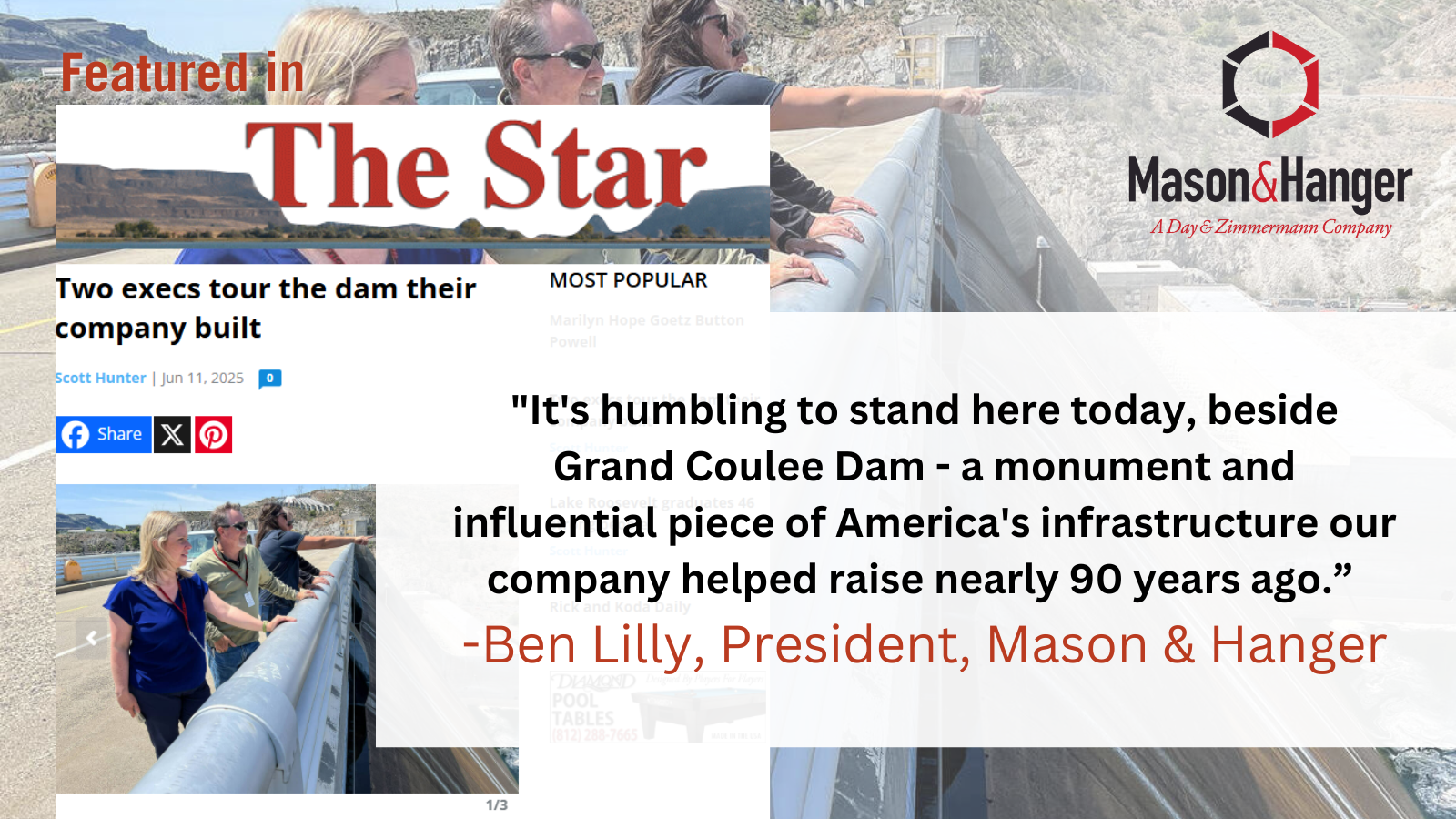As featured on The Star,
Two people trekked across the country last week to understand a piece of their Kentucky company's history, with a major claim to fame being the Grand Coulee Dam.
Now called Mason & Hanger, theirs was the lead company in the consortium of companies that built the original dam. They're the M in MWAK, the initials for Mason-Walsh-Atkinson-Kier.
On Wednesday, Ben Lilly, the president of Mason & Hanger, and Holly Holt, its vice president in charge of marketing, came to town to fill in the blanks in their knowledge about a very important past accomplishment of their company, which will celebrate turning 200 in a couple years.
They've hired a historian who has been working for a year to put together a company history, and it's the longest operating architecture/engineering firm in the country, Holt says.
"We are stewards of a 200-year legacy, and our role is to make sure the next generation knows the full, fascinating stories of America's infrastructure. History is everything, teaching us the path forward," she said.
In 1934, it was the Silas Mason Company when the Public Works Administration awarded the contract to build the largest concrete structure in the world in the middle of a raging river, a project that would require building a town in the middle of nowhere.
"There had to be a lot of head scratching from the engineers perspective to say, 'Well, how are you going to tackle this challenge?' mused Lilly, after a day spent touring deep inside Grand Coulee Dam. "And I think all along the way, there were some things that surprised them."

Holly Holt and Ben Lilly, executives at Mason & Hanger, a leading company in the construction of Grand Coulee Dam, look out from its top at the river below as Nikki Tonasket points out features to Bert Smith.
Lilly, who has spent decades engineering everything from redesigns of old U.S. embassies to a current project to build a vertical wind tunnel for NASA, would like a time machine so he could go back and find out what kind of information his predecessors had in order to know how to bid on the job.
But that's what he likes about the company: they take on interesting projects.
As the United States was about to enter into the fray of World War I, they built a city, named Old Hickory in honor of Andrew Jackson, to house 25,000 workers in support of a new black powder factory.
The company was started by Silas' grandfather, C.R. Mason, who built railroad bridges for the Confederacy. Bridge work led to tunnels, and one thing leads to another. As the company grew, it built larger projects, like the Catskills Aqueduct that still supplies New York City with water, and the Lincoln Tunnel, connecting Manhattan to New Jersey underneath the Hudson River, and the George Washington Bridge.
All impressive, but "Grand Coulee Dam is what really put Mason & Hanger on the map," Lilly says.
In Grand Coulee Dam's bowels Wednesday, the two executives, along with local historians Bert Smith and John Kemble, follow Bureau of Reclamation employee Nikki Tonasket into the pump-generator plant, one of their first stops after seeing the penstocks that deliver water to the canal that feeds Banks Lake and currently irrigates 710,000 acres of farmland from here to Pasco. It's all amazing, Lilly says later.
Lilly's eyes are wide, like those of an engineer who has found something amazing. He touches the side of one of the giant operating generators to feel for vibrations. Not much there.
On another stop, Lilly and Holt take selfies in a nearly mile-long tunnel inside the dam. And they watch a rotating shaft that's turning the guts of a massive generator on another floor overhead, linking the Columbia River's energy that's spinning the turbine below.
Holt got excited seeing copies of old MWAK safety posters displayed in an elevator, with some of the company's original safety slogans "a tangible link between past and present site culture."
That culture, pride perhaps, showed up as the tour moved on. Lilly noted the facility was clean and that "there wasn't a sour face on any of those guys" we happened to come across during the tour.
Lilly notes a difference from other federal facilities, and he's seen many, including many from that date from 1940s era.
"I think, from my viewpoint of the government installations, that's a pretty well-maintained facility," he said. "I didn't see the kind of challenges I've seen at other facilities."
"Mason & Hanger was part of the MWAK consortium that proved megaprojects could be delivered under extreme time pressure and economic hardship," Lilly said. "It's humbling to stand here today, beside Grand Coulee Dam - a monument and influential piece of America's infrastructure our company helped raise nearly 90 years ago."


